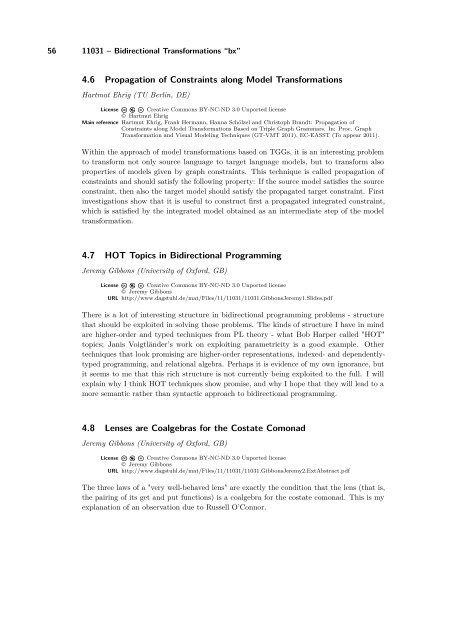Volume 1, Issue 1, January 2011 - DROPS - Schloss Dagstuhl
Volume 1, Issue 1, January 2011 - DROPS - Schloss Dagstuhl
Volume 1, Issue 1, January 2011 - DROPS - Schloss Dagstuhl
You also want an ePaper? Increase the reach of your titles
YUMPU automatically turns print PDFs into web optimized ePapers that Google loves.
56 11031 – Bidirectional Transformations “bx”<br />
4.6 Propagation of Constraints along Model Transformations<br />
Hartmut Ehrig (TU Berlin, DE)<br />
License Creative Commons BY-NC-ND 3.0 Unported license<br />
© Hartmut Ehrig<br />
Main reference Hartmut Ehrig, Frank Hermann, Hanna Schölzel and Christoph Brandt: Propagation of<br />
Constraints along Model Transformations Based on Triple Graph Grammars. In: Proc. Graph<br />
Transformation and Visual Modeling Techniques (GT-VMT <strong>2011</strong>), EC-EASST (To appear <strong>2011</strong>).<br />
Within the approach of model transformations based on TGGs, it is an interesting problem<br />
to transform not only source language to target language models, but to transform also<br />
properties of models given by graph constraints. This technique is called propagation of<br />
constraints and should satisfy the following property: If the source model satisfies the source<br />
constraint, then also the target model should satisfy the propagated target constraint. First<br />
investigations show that it is useful to construct first a propagated integrated constraint,<br />
which is satisfied by the integrated model obtained as an intermediate step of the model<br />
transformation.<br />
4.7 HOT Topics in Bidirectional Programming<br />
Jeremy Gibbons (University of Oxford, GB)<br />
License Creative Commons BY-NC-ND 3.0 Unported license<br />
© Jeremy Gibbons<br />
URL http://www.dagstuhl.de/mat/Files/11/11031/11031.GibbonsJeremy1.Slides.pdf<br />
There is a lot of interesting structure in bidirectional programming problems - structure<br />
that should be exploited in solving those problems. The kinds of structure I have in mind<br />
are higher-order and typed techniques from PL theory - what Bob Harper called "HOT"<br />
topics; Janis Voigtländer’s work on exploiting parametricity is a good example. Other<br />
techniques that look promising are higher-order representations, indexed- and dependentlytyped<br />
programming, and relational algebra. Perhaps it is evidence of my own ignorance, but<br />
it seems to me that this rich structure is not currently being exploited to the full. I will<br />
explain why I think HOT techniques show promise, and why I hope that they will lead to a<br />
more semantic rather than syntactic approach to bidirectional programming.<br />
4.8 Lenses are Coalgebras for the Costate Comonad<br />
Jeremy Gibbons (University of Oxford, GB)<br />
License Creative Commons BY-NC-ND 3.0 Unported license<br />
© Jeremy Gibbons<br />
URL http://www.dagstuhl.de/mat/Files/11/11031/11031.GibbonsJeremy2.ExtAbstract.pdf<br />
The three laws of a "very well-behaved lens" are exactly the condition that the lens (that is,<br />
the pairing of its get and put functions) is a coalgebra for the costate comonad. This is my<br />
explanation of an observation due to Russell O’Connor.













